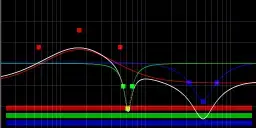Both Farview's post and ermghoti's post were right on the money, covering two different approaches or perspectives to the problem.
Farview's post described very good textbook general recipies for cleaning and shaping the instruments in question. Read it until you understand it inside and out.
Ermghoti described a common go-to technique used by practically every engineer at least once per project to really sweeten the sound of individual instruments. It not just "moving things around until they sound better"; there's a plan and a purpose to it. In short, you generously boost a band of parametric EQ (maybe 8-10dB should do it), and *slowly* sweep through the frequencies while playing one of your tracks back. When you find a frequency that really honks out at you when you sweep across it, center on that frequency and remove the boost and replace it with maybe 3-4dB of cut instead. This can really serve to "sweeten" the sound of a track, making it less muddy, and notching out more room for other instruments.
Follow those two posts and your mix will sound ten times better. HOWEVER, it requires paying attention and actually listening closely to the sounds coming out of your speakers. Before one can have success at mix equalization they really need to have at least a basic grasp on what the different frequency bands sound like. Being able to recognize and hear the difference between 150Hz and 400Hz or the difference between 3kHz and 6kHz (just for examples) is fundamental. It's not hard, it just requires a little practice and training. Take a night or three playing a variety of different CDs. Yeah, throw your favorite death metal band in there since that's what you do, but don't limit yourself to that. Grab one or two CDs from the categories of pop, jazz, country, classical, reggae or whatever as well.
Take some time for a cpouple of nights behind closed doors listening to these CDs closely with a 15-band (2/3rd octave) or 31-band (1/3rd octave) graphic EQ plug (or external EQ if you have one). Set the EQ to flat. As the songs play, slowly move the EQ bad sliders, one at a time starting at the left/bass side, up and down. Listen closely to the difference in sound boosting and cutting each band makes, *paying attention* to the actual color or character of the sound at that frequency. Notice what that band actually sounds like.
Do this for a few nights or so, then come back to your home recording mixes and you should discover a whole new level of understanding to what you're listening to, and your ears will suddenly be answering a lot of your EQ questions for you.
G.


